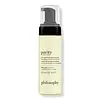What's inside
What's inside
 Key Ingredients
Key Ingredients

 Benefits
Benefits

 Concerns
Concerns

 Ingredients Side-by-side
Ingredients Side-by-side

Water
Skin ConditioningSodium Lauroamphoacetate
CleansingSodium Trideceth Sulfate
CleansingLimnanthes Alba Seed Oil
Skin ConditioningCoco-Glucoside
CleansingCoconut Alcohol
EmollientPEG-120 Methyl Glucose Dioleate
EmulsifyingGlycerin
HumectantPhenoxyethanol
PreservativeIsopropyl Alcohol
SolventCarbomer
Emulsion StabilisingPolysorbate 20
EmulsifyingChlorphenesin
AntimicrobialCitric Acid
BufferingDisodium Phosphate
BufferingAniba Rosaeodora Wood Oil
AstringentLinalool
PerfumingEthylhexylglycerin
Skin ConditioningXanthan Gum
EmulsifyingSodium Citrate
BufferingBulnesia Sarmientoi Wood Oil
MaskingPelargonium Graveolens Flower Oil
MaskingSodium Hydroxide
BufferingAmyris Balsamifera Bark Oil
MaskingCymbopogon Martini Oil
MaskingRosa Damascena Flower Oil
MaskingTocopherol
AntioxidantDaucus Carota Sativa Seed Oil
EmollientMimosa Tenuiflora Bark Extract
Skin ProtectingOrmenis Multicaulis Oil
MaskingPiper Nigrum Fruit Extract
PerfumingSalvia Sclarea Oil
MaskingSantalum Album Oil
MaskingCI 19140
Cosmetic ColorantWater, Sodium Lauroamphoacetate, Sodium Trideceth Sulfate, Limnanthes Alba Seed Oil, Coco-Glucoside, Coconut Alcohol, PEG-120 Methyl Glucose Dioleate, Glycerin, Phenoxyethanol, Isopropyl Alcohol, Carbomer, Polysorbate 20, Chlorphenesin, Citric Acid, Disodium Phosphate, Aniba Rosaeodora Wood Oil, Linalool, Ethylhexylglycerin, Xanthan Gum, Sodium Citrate, Bulnesia Sarmientoi Wood Oil, Pelargonium Graveolens Flower Oil, Sodium Hydroxide, Amyris Balsamifera Bark Oil, Cymbopogon Martini Oil, Rosa Damascena Flower Oil, Tocopherol, Daucus Carota Sativa Seed Oil, Mimosa Tenuiflora Bark Extract, Ormenis Multicaulis Oil, Piper Nigrum Fruit Extract, Salvia Sclarea Oil, Santalum Album Oil, CI 19140
Water
Skin ConditioningCocamidopropyl Betaine
CleansingDecyl Glucoside
CleansingLauryl Glucoside
CleansingPolysorbate 20
EmulsifyingGlycerin
HumectantSodium Chloride
MaskingHamamelis Virginiana Water
AstringentGlycolic Acid
BufferingSodium PCA
HumectantDisodium Cocoyl Glutamate
Cleansing1,2-Hexanediol
Skin ConditioningCaprylyl Glycol
EmollientAlcohol
AntimicrobialHydroxyacetophenone
AntioxidantSodium Cocoyl Glutamate
CleansingParfum
MaskingLinalool
PerfumingPhytic Acid
Lactobacillus Ferment
Skin ConditioningCarica Papaya Fruit Extract
Skin ConditioningLeuconostoc/Radish Root Ferment Filtrate
AntimicrobialWater, Cocamidopropyl Betaine, Decyl Glucoside, Lauryl Glucoside, Polysorbate 20, Glycerin, Sodium Chloride, Hamamelis Virginiana Water, Glycolic Acid, Sodium PCA, Disodium Cocoyl Glutamate, 1,2-Hexanediol, Caprylyl Glycol, Alcohol, Hydroxyacetophenone, Sodium Cocoyl Glutamate, Parfum, Linalool, Phytic Acid, Lactobacillus Ferment, Carica Papaya Fruit Extract, Leuconostoc/Radish Root Ferment Filtrate
 Reviews
Reviews

Ingredients Explained
These ingredients are found in both products.
Ingredients higher up in an ingredient list are typically present in a larger amount.
Glycerin is already naturally found in your skin. It helps moisturize and protect your skin.
A study from 2016 found glycerin to be more effective as a humectant than AHAs and hyaluronic acid.
As a humectant, it helps the skin stay hydrated by pulling moisture to your skin. The low molecular weight of glycerin allows it to pull moisture into the deeper layers of your skin.
Hydrated skin improves your skin barrier; Your skin barrier helps protect against irritants and bacteria.
Glycerin has also been found to have antimicrobial and antiviral properties. Due to these properties, glycerin is often used in wound and burn treatments.
In cosmetics, glycerin is usually derived from plants such as soybean or palm. However, it can also be sourced from animals, such as tallow or animal fat.
This ingredient is organic, colorless, odorless, and non-toxic.
Glycerin is the name for this ingredient in American English. British English uses Glycerol/Glycerine.
Learn more about GlycerinLinalool is a fragrance and helps add scent to products. It's derived from common plants such as cinnamon, mint, citrus, and lavender.
Like Limonene, this ingredient oxidizes when exposed to air. Oxidized linalool can cause allergies and skin sensitivity.
This ingredient has a scent that is floral, spicy tropical, and citrus-like.
Learn more about LinaloolPolysorbate 20 is made by combining ethoxylation of sorbitan, ethylene oxide, and lauric acid. It is a mild cleansing agent, surfactant, and emulsifier.
As a surfactant, it helps collect dirt and oils for washing. Emulsifiers prevent oils and water from separating.
Polysorbate 20 also adds scent to a product. Since it is made using sorbitol, it has a sweet scent. Sorbitol can also be found in fruits such as apples and peaches.
The lauric acid used to create Polysorbate 20 is often derived from coconuts.
Polysorbate 20 may not be fungal acne safe.
Learn more about Polysorbate 20Water. It's the most common cosmetic ingredient of all. You'll usually see it at the top of ingredient lists, meaning that it makes up the largest part of the product.
So why is it so popular? Water most often acts as a solvent - this means that it helps dissolve other ingredients into the formulation.
You'll also recognize water as that liquid we all need to stay alive. If you see this, drink a glass of water. Stay hydrated!
Learn more about Water